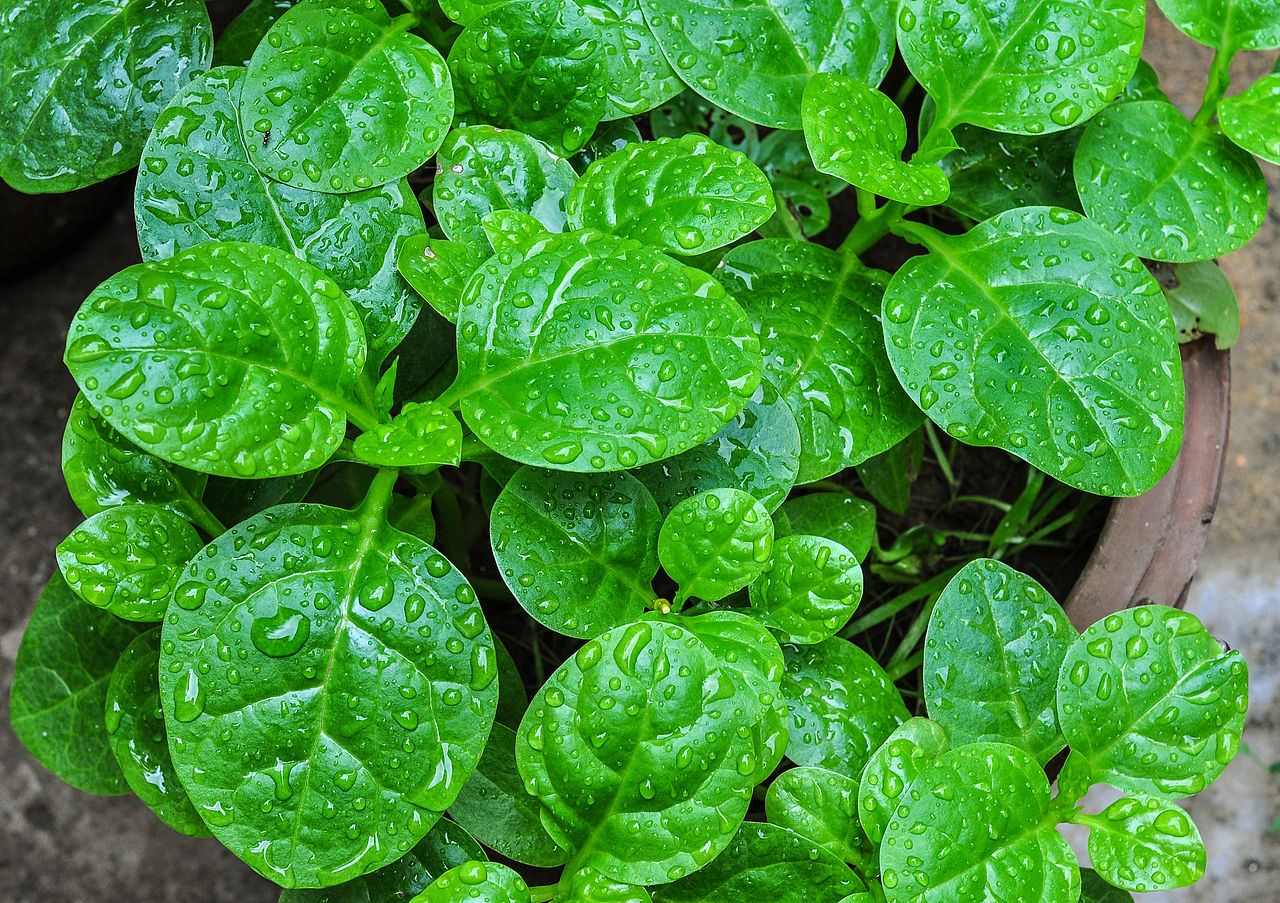By Kevann Jordan, Recent Arizona State University Nutrition Student
Malabar Spinach
March is almost over which means many of Arizona’s delicious produce options are coming into season, especially spinach. Spinach loves the cooler temperatures of spring and for those of us who love this nutritionally packed leaf, you have to enjoy it before it runs and hides from the coming heat!
What if I were to tell you about a spinach plant that loves the heat (in fact thrives in the heat), grows easily even for novice gardeners, and is insect resistant. Too good to be true? Well, let me introduce you to Malabar Spinach.

About Malabar Spinach
Malabar Spinach, also known as Basella alba, is also well known as Ceylon spinach, Indian spinach and Basella, but isn’t even really spinach. It is a semi succulent that is native to Asia. This beautiful plant grows on a vine and thrives when temperatures reach the 90’s. The leaves on Malabar Spinach are dark green and glossy. This delicious treat comes in two varieties: Rubra (Red stemmed) and Alba (green stemmed). The texture of Malabar spinach is slightly different than traditional spinach because the leaves are a bit thicker and they have a mild citrus and pepper flavor (which my kids really enjoy).
Benefits of Malabar Spinach
The Phoenix New Times covered this beautiful plant telling us how rich its leafy greens are in Vitamins A, C, iron, and calcium. It is also a good source of soluble fiber. Since Malabar spinach is a succulent it contains mucilage, which is a great detoxifier and is also very soothing if you’ve got digestive issues. DIYNatural.com says that Malabar Spinach is also a great source for plant protein and a noteworthy source of magnesium, phosphorus, and potassium. With the beautiful rich green and red color (in the Rubra variety) Malabar spinach contains beta carotene and lutein which are excellent antioxidants.
Eating Malabar Spinach
Malabar spinach can be eaten raw, sauteed, in soups or stir-fried. Dr. Andrew Weil recommends eating it with lime, chilies, coconut, garlic, and ginger. Most commonly, Malabar spinach is found in Asian Cuisine like curries, dal’s, and stir fries. You can always just add it to a sandwich, too, it doesn’t need to be complicated.
Malabar Spinach versus Traditional Spinach
Nutritional Facts
| Malabar Spinach | |
| Amount per:
100 grams |
% Daily Value
(based on 2000 cal diet) |
| Calories | 19 |
| Total Fat | 0.3g 0% |
| Cholesterol | 0mg 0% |
| Sodium | 24mg 1% |
| Potassium | 510mg 14% |
| Total Carbohydrate | 3.4g 1% |
| Protein | 1.8g 3% |
| Vitamin A | 160% |
| Vitamin C | 170% |
| Calcium | 10% |
| Iron | 6% |
| Vitamin D | 0% |
| Vitamin B-6 | 10% |
| Vitamin B-12 | 0% |
| Magnesium | 16% |
| Traditional Spinach | |
| Amount per:
100 grams |
% Daily Value
(based on 2000 cal diet) |
| Calories | 23 |
| Total Fat | 0.4g 0% |
| Cholesterol | 0mg 0% |
| Sodium | 79mg 3% |
| Potassium | 558mg 15% |
| Total Carbohydrate | 3.8g 1% |
| Protein | 0g 0% |
| Vitamin A | 187% |
| Vitamin C | 46% |
| Calcium | 9% |
| Iron | 15% |
| Vitamin D | 0% |
| Vitamin B-6 | 10% |
| Vitamin B-12 | 0% |
| Magnesium | 19% |
Malabar Spinach Salad with Orange-Poppy seed Dressing
Ingredients
½ of a small Cantaloupe
7 c. torn fresh Malabar Spinach
2 c. cubed lean ham
½ of a medium red onion, thinly sliced
½ c. toasted pecan halves
½ to 1 teaspoon finely shredded orange peel
2 tablespoons orange juice
2 tablespoons vinegar
1 tablespoon finely chopped onion
Dash of pepper
1/3 c. Olive oil or grapeseed oil
1 teaspoon poppy seeds
3 tablespoons sugar
Directions
- In a food processor bowl or blender container combine sugar, orange peel, orange juice, vinegar, the finely chopped onion, and pepper. Cover and process or blend until combined. With the processor or blender running, slowly add oil in a steady stream through hole or opening in top. Process or blend until mixture is thickened. Stir in poppy seed. Use immediately or cover and chill in the refrigerator until needed. Shake before using.
- Remove the seeds and peel from the cantaloupe. Thinly slice the cantaloupe lengthwise; using miniature cutters, cut the melon into stars. (Or, use a melon baller to scoop the melon half into balls.) In a large serving bowl toss together cantaloupe, spinach, ham, and red onion. Add pecans; pour half of the dressing over all. Toss to coat. (Cover and chill remaining dressing up to 3 days.) Makes 4 main-dish or 8 side-dish servings.
- Make-Ahead Tip: Prepare dressing; cover and chill up to 3 days. Prepare cantaloupe-spinach mixture as above. Cover and refrigerate for up to 8 hours. Before serving, add pecans; pour dressing over all. Toss to coat.
Recipe courtesy: Rose Creek Farms

